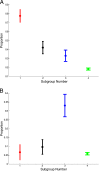Comorbidity clusters in autism spectrum disorders: an electronic health record time-series analysis
- PMID: 24323995
- PMCID: PMC3876178
- DOI: 10.1542/peds.2013-0819
Comorbidity clusters in autism spectrum disorders: an electronic health record time-series analysis
Abstract
Objective: The distinct trajectories of patients with autism spectrum disorders (ASDs) have not been extensively studied, particularly regarding clinical manifestations beyond the neurobehavioral criteria from the Diagnostic and Statistical Manual of Mental Disorders. The objective of this study was to investigate the patterns of co-occurrence of medical comorbidities in ASDs.
Methods: International Classification of Diseases, Ninth Revision codes from patients aged at least 15 years and a diagnosis of ASD were obtained from electronic medical records. These codes were aggregated by using phenotype-wide association studies categories and processed into 1350-dimensional vectors describing the counts of the most common categories in 6-month blocks between the ages of 0 to 15. Hierarchical clustering was used to identify subgroups with distinct courses.
Results: Four subgroups were identified. The first was characterized by seizures (n = 120, subgroup prevalence 77.5%). The second (n = 197) was characterized by multisystem disorders including gastrointestinal disorders (prevalence 24.3%) and auditory disorders and infections (prevalence 87.8%), and the third was characterized by psychiatric disorders (n = 212, prevalence 33.0%). The last group (n = 4316) could not be further resolved. The prevalence of psychiatric disorders was uncorrelated with seizure activity (P = .17), but a significant correlation existed between gastrointestinal disorders and seizures (P < .001). The correlation results were replicated by using a second sample of 496 individuals from a different geographic region.
Conclusions: Three distinct patterns of medical trajectories were identified by unsupervised clustering of electronic health record diagnoses. These may point to distinct etiologies with different genetic and environmental contributions. Additional clinical and molecular characterizations will be required to further delineate these subgroups.
Keywords: autism; clustering; comorbidity; psychiatric disorders; seizure.
Figures






References
-
- Xue Ming, Brimacombe M, Chaaban J, Zimmerman-Bier B, Wagner GC. Autism spectrum disorders: concurrent clinical disorders. J Child Neurol. 2008;23(1):6–13 - PubMed
-
- Coury D. Medical treatment of autism spectrum disorders. Curr Opin Neurol. 2010;23(2):131–136 - PubMed
-
- Smith RD. Abnormal head circumference in learning-disabled children. Dev Med Child Neurol. 1981;23(5):626–632 - PubMed
MeSH terms
Grants and funding
LinkOut - more resources
Full Text Sources
Other Literature Sources

